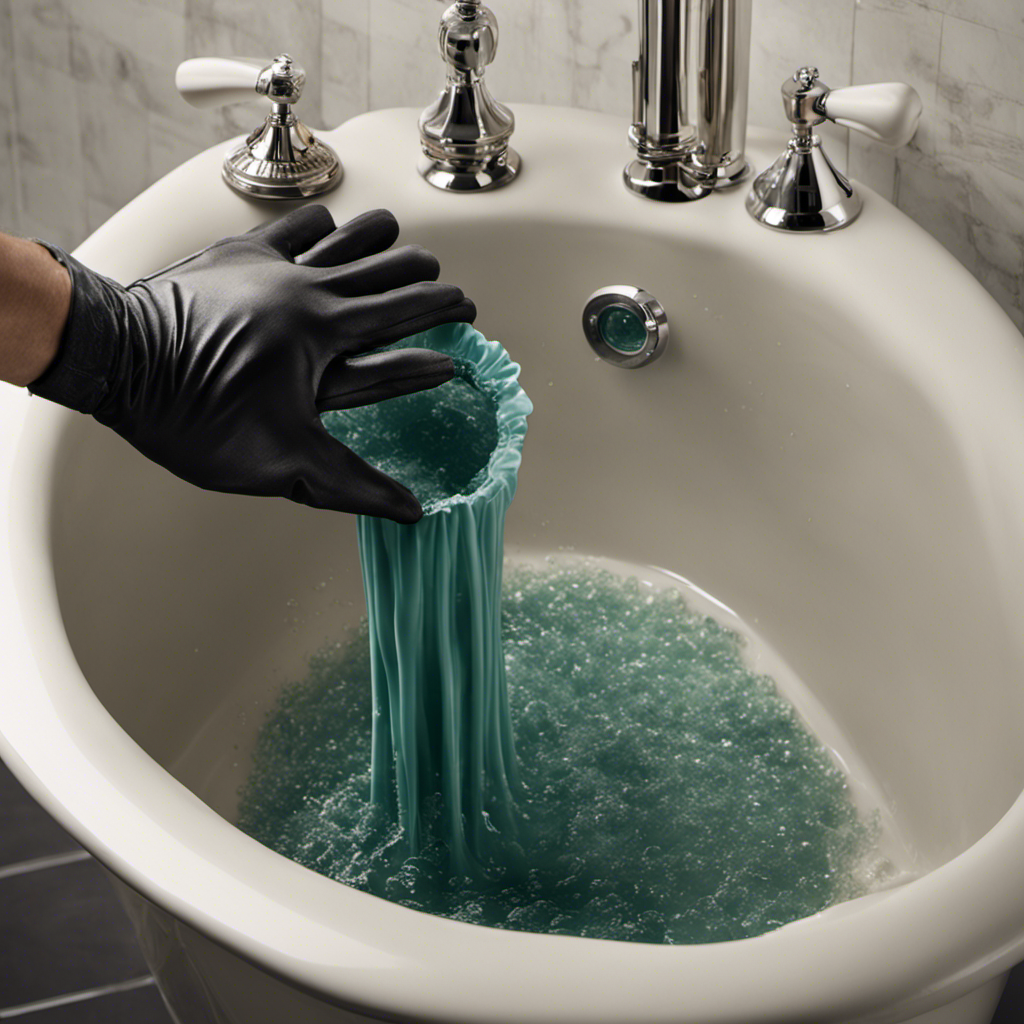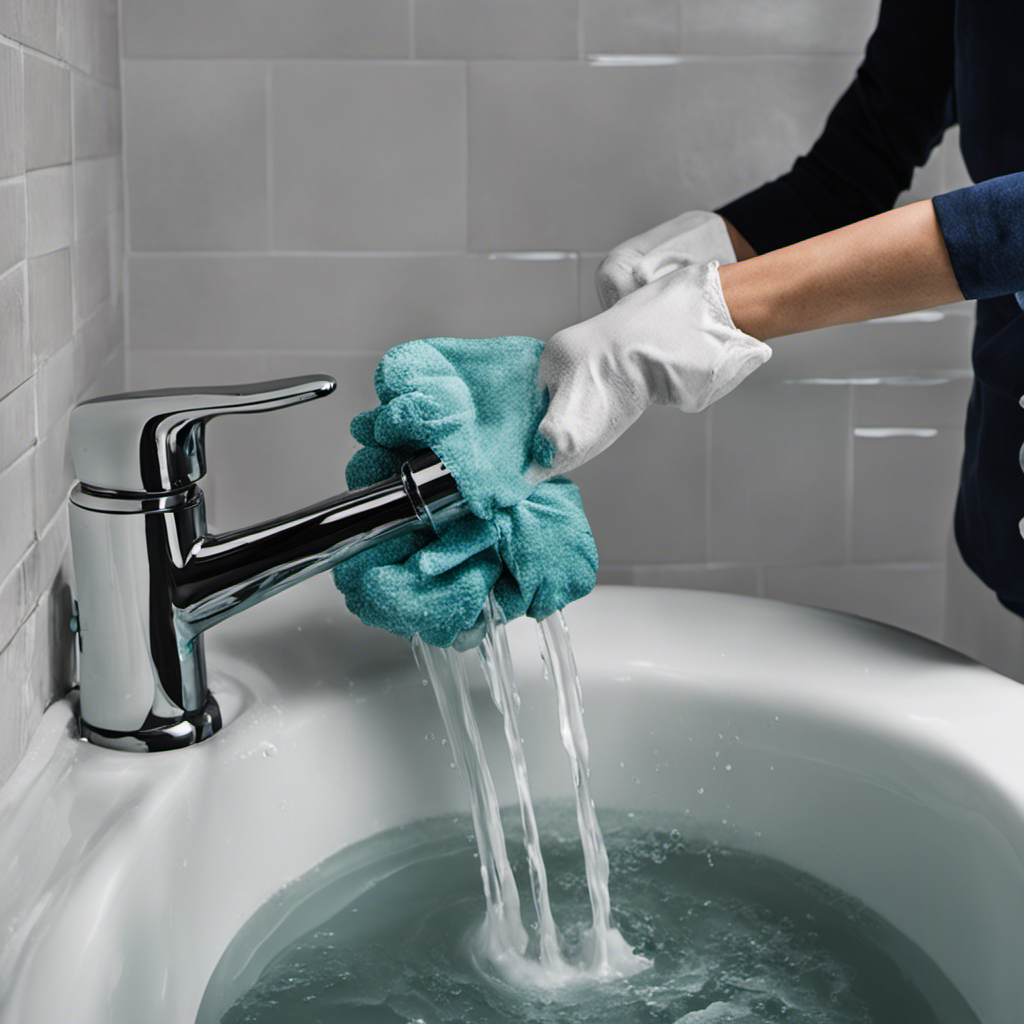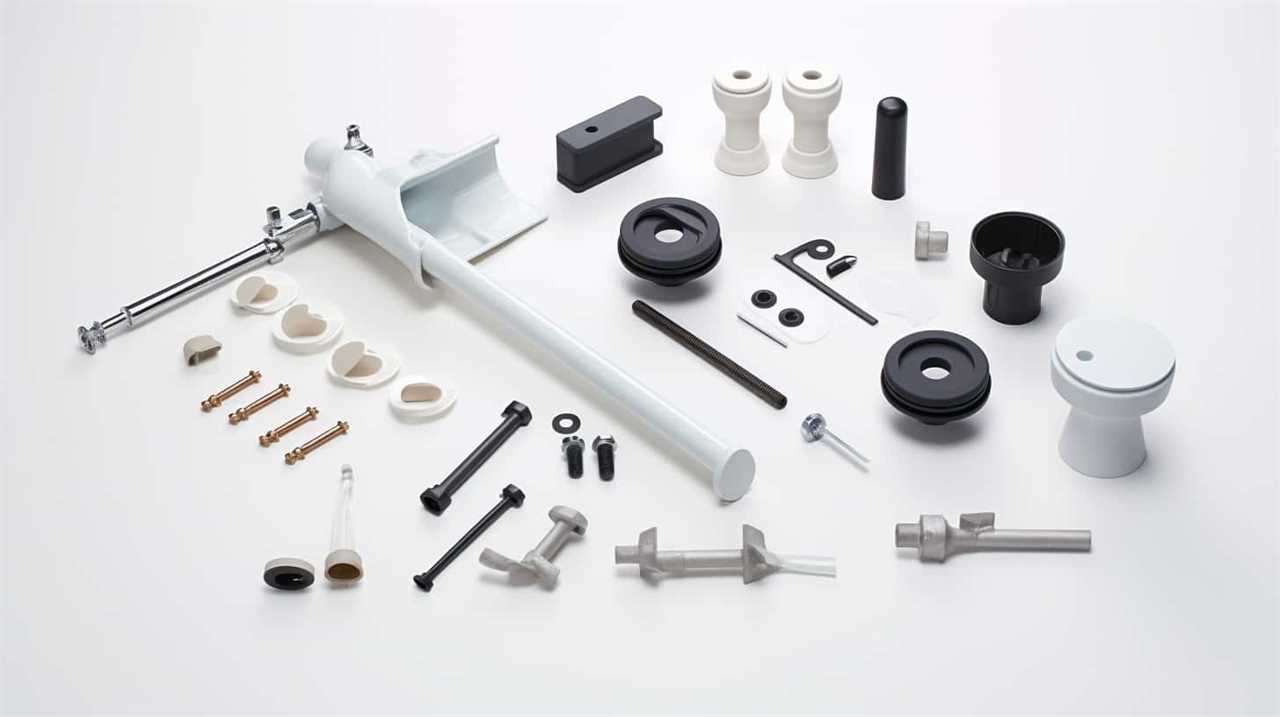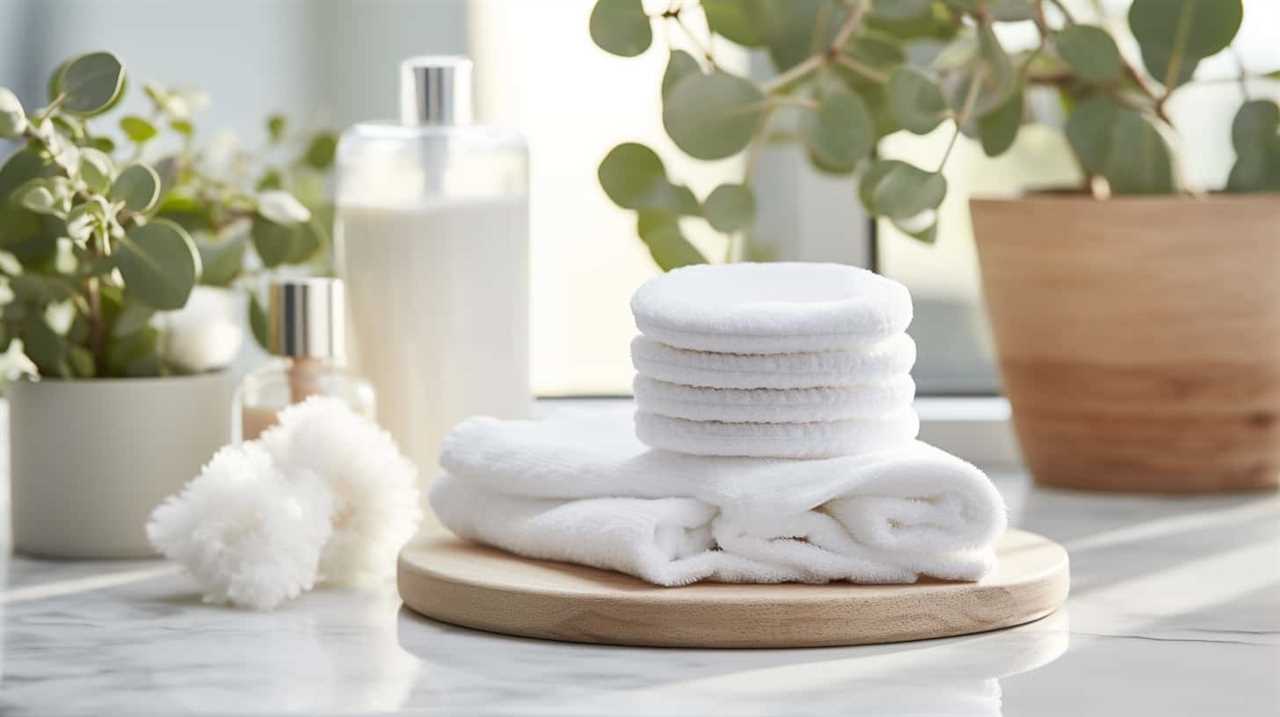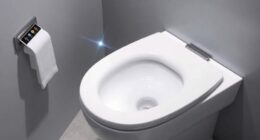Hey there!
Have you ever felt like your bathtub drain is as clogged as rush hour traffic? Well, fear not! In this handy guide, I’ll walk you through the step-by-step process of unclogging your bathtub drain.
Armed with a few common tools and a little bit of know-how, you’ll be able to tackle those pesky clogs like a pro.
So, let’s dive in and get that water flowing freely again!
Key Takeaways
- Slow drainage is a common sign of a clogged bathtub drain.
- Hair, soap scum, debris, and foreign objects can cause clogs.
- Hard water mineral deposits can restrict water flow and lead to clogs.
- Tools and materials like a plunger, drain snake, bucket, baking soda, vinegar, and hot water can help in unclogging the drain.
Understanding the Causes of Bathtub Drain Clogs
You’ll want to understand the causes of bathtub drain clogs in order to effectively unclog your drain.
Slow drainage is one of the most common signs of a clogged bathtub drain. This can be caused by a buildup of hair, soap scum, or other debris that accumulates over time.
Another common cause is the accumulation of mineral deposits, especially in areas with hard water. These deposits can restrict the flow of water and lead to clogs.
Additionally, foreign objects like toys or jewelry accidentally dropped into the drain can also cause blockages.
Understanding these causes will help you determine the best approach for unclogging your drain.
Now that you know what causes clogs, let’s move on to identifying the tools and materials you’ll need to get the job done.
Identifying the Tools and Materials You’ll Need
Before starting, gather the necessary tools and materials needed for the task. The following table provides a comprehensive list of the tools and equipment that you will need to successfully unclog your bathtub drain:
| Tools | Materials |
|---|---|
| Plunger | Rubber Gloves |
| Drain Snake | Baking Soda |
| Bucket | Vinegar |
| Screwdriver | Hot Water |
| Pipe Wrench | Cleaning Brush |
Now that you have gathered all the required tools and materials, let’s move on to the step-by-step instructions. First, put on your rubber gloves to protect your hands. Then, remove the drain stopper or cover using a screwdriver if necessary. Use the plunger to create a strong seal around the drain and start plunging vigorously. If that doesn’t work, insert the drain snake into the drain and twist it to dislodge any clogs. Next, pour a mixture of baking soda and vinegar down the drain, followed by hot water. Finally, use a cleaning brush to scrub away any remaining debris.
Preparing the Bathtub for Drain Unclogging
First, I’ll discuss the process of removing the drain cover, which is an essential step in preparing the bathtub for drain unclogging. I’ll explain the importance of this step and provide detailed instructions on how to safely and effectively remove the drain cover.
Next, I’ll address the issue of hair buildup, which is a common cause of bathtub drain clogs. I’ll explain why hair buildup occurs and provide tips on how to effectively clear it out using simple techniques and tools.
Removing Drain Cover
To remove the drain cover, simply use a screwdriver to loosen the screws.
It’s important to regularly maintain the drain cover to prevent hair buildup, which can lead to clogs in the bathtub drain. Hair removal tools such as drain snakes or hair catchers can also be used to minimize the amount of hair that goes down the drain.
Once the screws are loosened, gently lift the drain cover off the drain opening. Be careful not to drop the screws down the drain.
Now that the drain cover is removed, we can move on to clearing the hair buildup that may have accumulated in the drain pipe.
Clearing Hair Buildup
You can clear the hair buildup in the drain pipe by using a drain snake or hair catcher. Hair removal products are also effective in DIY drain cleaning. Here are three options to consider:
-
Drano Max Gel Clog Remover: This powerful gel formula is specifically designed to dissolve hair clogs in drains. It works quickly and efficiently, making it a popular choice for many homeowners.
-
Zip-It Drain Cleaning Tool: This inexpensive tool is a simple yet effective way to remove hair clogs from your drain. It features barbed edges that easily grab onto hair and pull it out.
-
Baking Soda and Vinegar: A natural and eco-friendly option, mixing baking soda and vinegar creates a foaming reaction that helps break down hair and other debris in the drain.
Remember to always follow the instructions provided by the manufacturer when using hair removal products and exercise caution to avoid any damage to your plumbing system.
Removing Hair and Debris From the Drain Opening
When it comes to dealing with clogged drains, there are several key points to consider.
Firstly, hair removal techniques are important in effectively removing hair and debris from the drain opening. It is crucial to use the right tools and techniques for this task.
Secondly, clearing drain blockages requires a thorough understanding of the underlying cause. It is important to use appropriate methods to address the issue and ensure a successful clearing process.
Lastly, taking preventive measures is essential in preventing future clogs. Using drain covers and performing regular maintenance can greatly reduce the chances of experiencing clogs in the future.
Hair Removal Techniques
Once the drain is clear, start by purchasing a drain snake or using a wire hanger to remove any hair clogs. This is an essential step in preventing clog recurrence.
Here are some effective hair removal techniques to keep your bathtub drain running smoothly:
- Regularly clean the drain opening by using a drain cover or strainer to catch hair and debris before it goes down the drain.
- Use a mixture of baking soda and vinegar to dissolve any hair buildup in the drain. Pour half a cup of baking soda down the drain, followed by a cup of vinegar. Let it sit for about 30 minutes, then flush with hot water.
- Consider using an enzymatic drain cleaner specifically designed to break down and remove hair clogs.
Clearing Drain Blockages
To effectively clear blockages in your drain, start by using a drain snake or wire hanger to remove any hair clogs. Once the hair is cleared, you may encounter chemical blockages that require a different approach.
One effective method for clearing chemical blockages is by using a drain auger. A drain auger, also known as a plumber’s snake, is a long, flexible tool that can reach deep into your drain pipes. It works by breaking up and removing any stubborn clogs that are causing the blockage.
When using a drain auger, it’s important to follow these steps for maximum effectiveness:
- Insert the drain auger into the drain opening.
- Slowly rotate the handle of the auger while pushing it further into the drain.
- Continue rotating and pushing until you feel resistance.
- Once you encounter resistance, slowly retract the auger while continuing to rotate it to break up the clog.
Preventing Future Clogs
You can easily prevent future clogs in your drains by regularly cleaning the hair and debris from your sink and shower drains. This simple maintenance task can save you from the hassle and expense of dealing with a clogged drain in the future.
Here are three key tips to help you avoid chemicals and maintain your drains effectively:
-
Use a drain strainer: Install a drain strainer in your sink and shower drains to catch hair and large debris before they enter the pipes. This will significantly reduce the amount of material that can cause clogs.
-
Flush with hot water: Once a week, pour a pot of boiling water down each drain to dissolve any buildup and flush away potential clogs. Hot water is a natural and chemical-free way to keep your drains clean and flowing smoothly.
-
Regularly clean the P-trap: Unscrew the P-trap, located underneath your sink, and clean it out to remove any accumulated debris. This will prevent clogs from forming in the curved section of the pipe.
Using a Plunger to Clear the Clog
If it’s not working, try using a plunger to clear the clog in your bathtub drain. This is a simple and effective method that can save you time and money.
To start, make sure there is enough water in the bathtub to cover the rubber part of the plunger. Place the plunger over the drain and push down firmly, creating a seal. Then, quickly pull up and down to create suction and pressure. Repeat this motion several times until the clog is cleared.
If using a plunger doesn’t work, you can consider using a chemical cleaner or calling a plumber for further assistance. However, it’s important to exercise caution when using chemical cleaners, as they can be harmful to your health and the environment.
Transitioning into the next section, let’s explore applying natural drain cleaning solutions as an alternative option.
Applying Natural Drain Cleaning Solutions
Applying natural drain cleaning solutions can be a safer and more eco-friendly alternative to using chemical cleaners. Not only are these homemade drain cleaners good for the environment, but they are also gentle on your pipes and can be made with ingredients you likely already have in your kitchen.
Here are three effective natural drain cleaning solutions:
-
Baking Soda and Vinegar: Mix equal parts baking soda and vinegar and pour it down the drain. The mixture will create a foaming action that helps break down clogs and remove odors.
-
Salt and Hot Water: Dissolve half a cup of salt in a pot of hot water and pour it down the drain. The hot water will dissolve grease and the salt will help scrub away any residue.
-
Lemon Juice and Baking Soda: Sprinkle baking soda down the drain and then pour lemon juice over it. The combination will create a fizzing reaction that helps remove buildup and freshen the drain.
Utilizing a Drain Snake for Stubborn Clogs
To tackle stubborn clogs, try utilizing a drain snake for a more effective and efficient solution. A drain snake, also known as a plumbing snake or auger, is a tool specifically designed to remove clogs from pipes. It consists of a long, flexible metal cable with a coiled end that can be inserted into the drain. As the cable is pushed further into the pipe, it breaks up the clog and allows water to flow freely again.
If you don’t have a drain snake on hand, there are a few alternatives you can try. For example, you can use a plunger to create suction and dislodge the clog. Another option is using a mixture of baking soda and vinegar to dissolve the clog.
When using a drain snake, it’s important to follow a few tips for better results. First, make sure to wear protective gloves to avoid contact with any debris or bacteria. Start by inserting the coiled end of the drain snake into the drain and slowly turning the handle clockwise. This will help guide the cable down the pipe and break up the clog. Once you feel resistance, rotate the handle counterclockwise to retrieve the cable, along with the clog. Remember to clean the drain snake thoroughly after each use to prevent the spread of bacteria.
Flushing the Drain With Hot Water
When it comes to unclogging a drain, one method that often gets overlooked is flushing it with hot water. This simple yet effective technique can help break down and wash away stubborn clogs.
The key lies in using the right water temperature, understanding the benefits of hot water, and knowing when to consider other unclogging methods.
Water Temperature for Flushing
You can use hot water to flush the bathtub drain and help remove any clogs. When it comes to water temperature for flushing, it’s important to strike the right balance. Here are a few key points to keep in mind:
-
Avoid extreme temperatures: Hot water is effective in breaking down grease and soap scum, but using boiling water can damage your pipes. Stick to warm or hot water that is safe for your plumbing system.
-
Consider water pressure: A strong water flow can help dislodge debris and push it through the drain. If your water pressure is low, you may need to use a higher temperature to compensate.
-
Skip the chemical cleaners: While chemical drain cleaners may seem like a quick fix, they can be harsh on your pipes and harmful to the environment. Hot water is a safer and more eco-friendly option.
By using hot water at the right temperature and avoiding harsh chemical cleaners, you can effectively unclog your bathtub drain without causing any damage.
Now, let’s explore the benefits of using hot water for this task.
Benefits of Hot Water
Using hot water can effectively break down grease and soap scum, making it easier to remove debris from your pipes. When the water temperature is higher, it increases the kinetic energy of the molecules, causing them to move faster and break apart the clogs more efficiently.
Additionally, hot water can also provide health benefits. The steam produced by hot water can help open up your nasal passages and relieve congestion. It can also help relax your muscles and promote better blood circulation.
However, it’s important to note that hot water should be used with caution, as excessive heat can damage certain types of pipes.
In the next section, we will explore other unclogging methods that can be used in conjunction with hot water to effectively clear your bathtub drain.
Other Unclogging Methods
If you’re looking for alternative ways to clear a clog in your bathtub, there are several methods you can try. Here are some options to consider:
-
Using a Plunger: This classic method can be effective in dislodging clogs caused by hair and other debris. Simply place the plunger over the drain and vigorously plunge up and down to create suction.
-
Chemical Drain Cleaners: These products can dissolve hair and other clog-causing substances. Follow the instructions carefully and use them sparingly to avoid damaging your pipes.
-
Hair Removal Techniques: Regularly cleaning the drain by manually removing hair can help prevent clogs from forming. Use a drain snake or tweezers to pull out any hair that has accumulated.
In addition to these unclogging methods, it’s important to take preventative measures to avoid future clogs. Use a drain cover to catch hair and debris, and regularly clean the drain to prevent buildup.
Preventative Measures to Avoid Future Clogs
To prevent future clogs, it’s important to regularly clean the drain and avoid pouring grease down the bathtub drain. One way to maintain a clean drain is by using natural solutions instead of chemical cleaners. Chemical cleaners can be harsh on your plumbing system and may even cause more harm than good. Instead, consider using a mixture of baking soda and vinegar. Simply pour half a cup of baking soda down the drain, followed by half a cup of vinegar. Let it sit for about 30 minutes and then flush it with hot water. This natural solution helps to break down any buildup in the pipes. Additionally, incorporating a regular maintenance routine can help keep your drain clear. Here’s a table to illustrate a simple maintenance routine:
| Day | Task |
|---|---|
| Monday | Pour boiling water down |
| Wednesday | Use a drain snake |
| Friday | Clean drain cover |
| Sunday | Repeat baking soda method |
Seeking Professional Help for Persistent Clogs
Have you considered reaching out to a professional plumber for assistance with persistent clogs? While DIY unclogging methods can be effective for minor clogs, sometimes it’s best to leave the job to the experts.
Here are a few reasons why hiring a professional for drain cleaning can be a wise choice:
-
Expertise: Professional plumbers have the knowledge and experience to quickly identify and resolve complex clogs that may be causing repeated issues.
-
Specialized Tools: Professionals have access to advanced tools and equipment specifically designed for unclogging drains, ensuring a thorough and long-lasting solution.
-
Cost-Effective: Although professional drain cleaning services come at a cost, they can save you money in the long run by preventing further damage or the need for frequent repairs.
When it comes to persistent clogs, investing in professional assistance can provide peace of mind and a more efficient solution.
Frequently Asked Questions
Can I Use a Chemical Drain Cleaner to Unclog My Bathtub Drain?
I wouldn’t recommend using chemical drain cleaners to unclog a bathtub drain. There are alternative drain cleaning methods that are safer and more effective, such as using a plunger or a drain snake.
How Long Does It Typically Take to Unclog a Bathtub Drain Using a Plunger?
Using a plunger to unclog a bathtub drain can be effective, but it depends on the severity of the clog. It typically takes a few minutes of vigorous plunging to clear the blockage. To prevent future clogs, avoid dumping hair and debris down the drain.
Is It Safe to Use a Drain Snake if I Have a Septic System?
Using a drain snake with a septic system is generally safe, but caution is advised to prevent damage. If you’re concerned, consider alternative methods like using a plunger or a natural enzyme drain cleaner.
What Should I Do if the Clog Keeps Coming Back After Using Natural Drain Cleaning Solutions?
If the clog keeps coming back after using natural drain cleaning solutions, I would consider using professional drain cleaning services. Additionally, I would explore alternative methods for preventing future clogs.
When Should I Consider Calling a Professional Plumber to Unclog My Bathtub Drain?
When the clog keeps coming back after using natural solutions, it’s time to consider calling a professional plumber for help. They have the expertise and tools to effectively unclog your bathtub drain.
Conclusion
In conclusion, folks, unclogging a bathtub drain is truly a delightful experience that I highly recommend to everyone.
There’s nothing quite like the thrill of pulling out clumps of hair and debris from your drain, or the satisfaction of plunging away at a stubborn clog.
And let’s not forget the joy of using a drain snake to navigate the intricate twists and turns of your pipes.
So, my friends, embrace the adventure of unclogging your bathtub drain and enjoy the rush of hot water flowing freely once again.
Trust me, it’s an experience you won’t want to miss!
